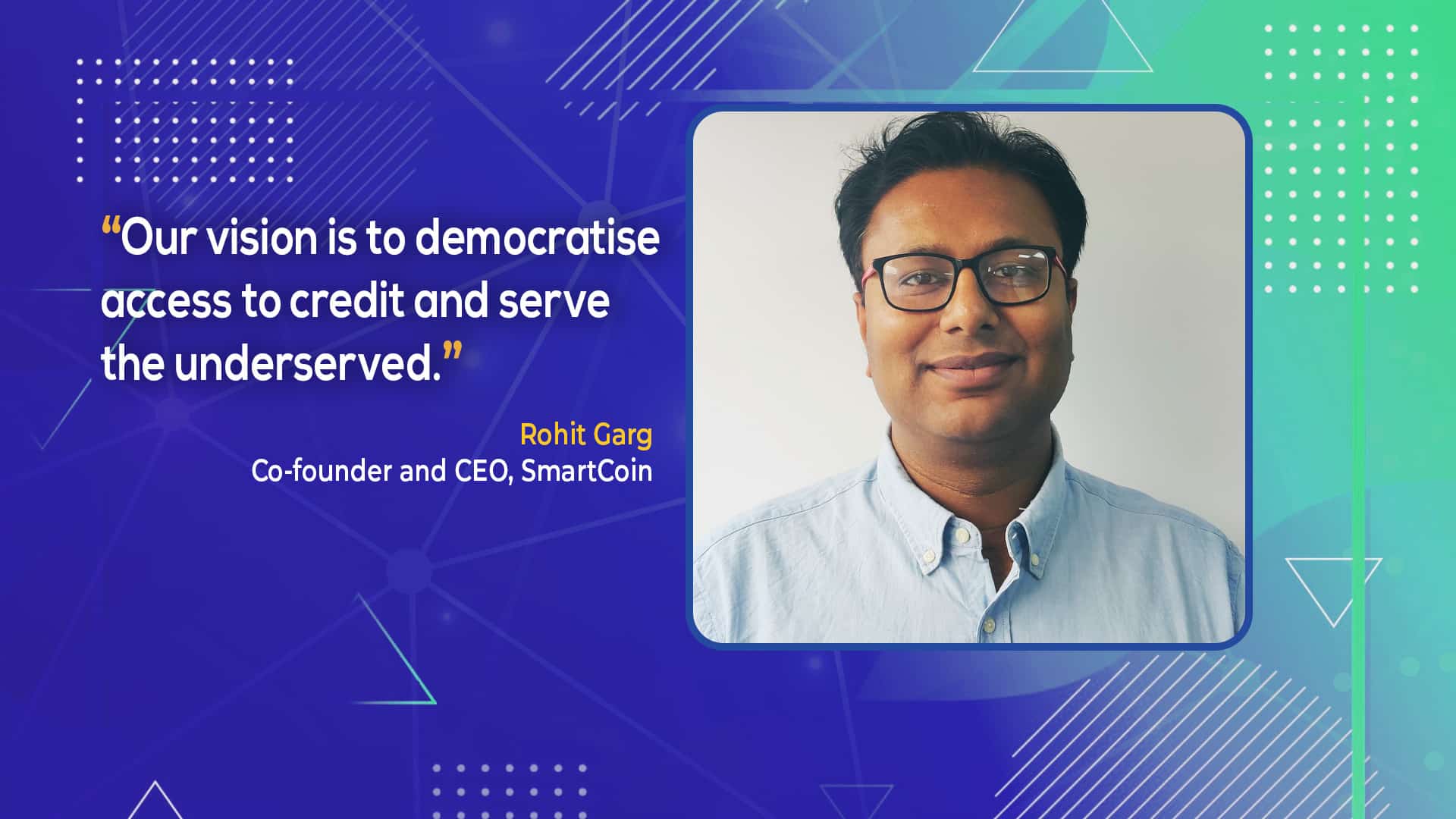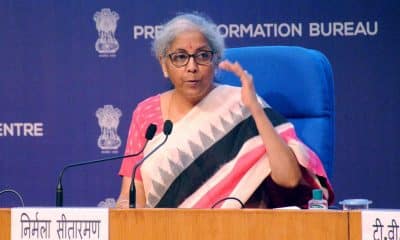In Conversation
This fintech startup is changing the game in India’s microlending space
“What is happening right now in India is that people who are above a certain income group get easy access to credit. A person like you or me, get call for loans and credit card every other day. If you own two credit cards, you would get calls for five and then there are people in lower income segment who get neither, says Rohit Garg, Co-Founder & Chief Executive Officer at SmartCoin.
Garg co-founded SmartCoin along with his fellow IIT alumni Amit Chandel, Vinay Kumar Singh and Jayant Upadhyay in 2016. The Bengaluru-headquartered company extends small to mid-size ticket loans to mobile users through credit scores created using machine learning algorithms. The fintech platform leverages data, mobile access, and India’s digital infrastructure to extend loan access for the financially underserved.
In an interview with The Plunge Daily, Mr Garg underscored the need to democratise access to credit and highlighted the key challenges in India’s fintech space.
Q: It’s been around five years since you, along with three of your colleagues co-founded this platform. Please take us through your journey.
A: Almost four or five years back, when lots of startups had started coming up, we realised there is massive scope for tech-enabled financial services in our country. We also observed that the majority of fintechs were focusing on urban or typical white collar segments. So that’s when we thought that something should happen. The opportunity was big, there should be a mechanism to serve the informal sector which has largely been deprived of financial services. Also, India was witnessing a sort of digital revolution with the availability of affordable smartphones and cheaper data charges. So, a guy who is earning very low or living in a remote corner of the country was also digitally active. The idea was to leverage the ongoing digitalisation and reach out to masses through a data-driven approach.
If I were to brief it, we have majorly innovated on two, three area. Firstly, we have reconstituted the entire life cycle of lending to make it 100%, digital and automated. And that has helped us to reach the length and breadth of the country in making these products available. So, we only have headquarter in Bangalore, we don’t have any other physical branches or anything, but still we have served people in more than 98% districts in India. So, like a grocery shopkeeper in Arunachal Pradesh or a person in Jammu Kashmir, he’s using our app to send money back home. We have a hotel owner in Andaman & Nicobar who is using capital from us to invest in his business. So, we have now lakhs of such stories where we have been able to help people. And that is something we have been able to do.
And second thing where we did a lot of work was how to use technology and digital data, to go beyond the typical CIBIL scores and hard-coded form of risk assessment, to actually give a chance to everyone and work with their data flexibly to give them credit. So, we’ve created our own machine learning and, alternate database using our in-house technology. And these things have helped us to serve more than 7 million users across the country.
Q: SmartCoin’s key focus is to enable credit to the underserved middle and lower-income segments of the country. Can you tell us more about your products and the sectors for which the credit facility is available?
A: While I have already delved into the reasons why low-income segment has largely remained underserved, another key thing you will notice is that there has hardly been any product innovation on the financial services side. If you recall, decades back FMCG industry realised that rural market have different set of needs than urban market. Then, they came up with the sachet products which enabled poor rural consumers to buy expensive brands of daily consumables like soap, shampoo etc. Similarly, telcos also reached a wider-audience by introducing chota recharge.
Similarly, when you are talking of people who are working in middle and lower income segments, we figured they don’t always need a credit of two lakh or five lakh. What they need is a frequent and reliable access to microcredit. For instance, a shopkeeper might need Rs 10,000 to buy inventory for his shop or a factory worker may need Rs 5000 to pay tuition fees of his kid. We have seen drivers seeking Rs 2000 for petrol to get going for the day. So, no one actually provide these products. While this is the biggest source of use case for the lower and middle income segment.
So, we help them get microcredit starting from as low as 1000 rupees, and going up to Rs 1 lakh. And we provide flexible tenure starting from a couple of months to going up to 12 months or longer, depending on what the customer need is. So we have been able to personalize and make the products very flexible unlike large banks and NBFCs where the lending process is quite complicated. So, we deliver our services through a complete mobile based experience. So we have a mobile app , available free of cost, in eight languages. The flow is very intuitive, you don’t need any excess documentation or paperwork. You can access it from anywhere. All you need to do is to just apply on the app, and then they’ll ask you some simple questions. And once that are answered, it will quickly analyse your profile and almost instantly, it will tell you the decision and give you the loan amount. You don’t have to stand in any queue do any paperwork, or wait for days to process a loan.
Also Read: How Leegality is enabling businesses to go completely paperless
Q: SmartCoin reportedly saw a lot of traction during the festive season and helped customers in need for instant cash. Please share with us how you managed to exceed the pre-covid figures this season
A: Two trends, in general, have emerged post second wave. We have seen a surge in capital demand because we are seemingly in a stable phase, where businesses are looking to rebuild, reinvest and grow. Job situation is also getting better. So a lot of people are very confident about spending as well as investing in the future. And with the onset of festive season, all of these factors came together. I would say, during the pandemic, for the large part, we were seeing a lot more demand for medical related use cases, loans for travel related use cases or for businesses, they had gone down relatively. The festive season demand for this year was, at least, 20% higher than last year. Before pandemic, we used to give loans for a variety of use cases to our customers and it is happening again. A lot of people have started taking capital for investing in their working capital or to buy a consumer durable and investing in home or shop renovation.
Q: Please share with us your business revenue model. Has SmartCoin become profitable?
A: In terms of our business model, we provide credit to our customers through our own balance sheet as well as through our partners. This allows us to make interest income and fee income from our customers. And that’s our primary source of income. We have seen continued growth in our core business due to the very differentiated value proposition that we are offering, because we are one of the few fintechs working on providing credit, across all the locations, across all the geographies, as well as across all sort of profiles in India. As I have said, we are focusing on the middle income mass market, which is largely not served by formal banks and NBFCs. So, we have seen a very strong growth and traction on that end and that has helped us to also actually become profitable in the process.
Q: Pandemic has led to massive digital adoption across India. Please share with us the challenges and opportunities that came along with covid.
A: I would say COVID posed a lot of short term challenges. We saw, in the first wave, impact on people’s livelihood and the second wave was much more tragic in terms of personal losses. But beyond that, if you look at it from a medium to long term perspective, it has brought a lot of positive changes. The digital acceleration has happened at an unprecedented rate during this period. We started with the premise that the entire country will be
digitally active, and that will help us provide them very convenient, affordable, and reliable financial services. However, when we also begin to be honest, we thought that we will be able to serve the first million people in a gradual manner and then . But today, that growth has surpassed our expectations as well, we have half a billion active smartphone users in the country and that’s a huge number.
When we’re starting out, we were told, financial services is a complicated business. And you’re going after a segment, which is perceived as less literate. So, their concern always was how would you explain to them as they are not financially literate, but what we have realised people are getting tech literate very fast. If you go to a rural area and talk to a farmer or a worker, they understand how to operate smartphones and if you build good user-friendly app, people will be inclined to use your products. These things have provided us great opportunities, because now you can be very strong, consumer focused products, and serve them in their language, in a way it works for them. Earlier, most of our shopkeepers were transacting in cash but now post pandemic, a significant portion have shifted to UPI transactions. So, we are quite bullish on that as well.
Q: Fintech platforms have emerged as one of the most important sectors among the new age startups. How do you see the financial services industry changing in coming years
A: I think it will change in multiple forms. So, if we talk about the process of lending and customer experience, it is going to change massively. Even today, availing financial services and specially loans is widely-perceived to be tedious and cumbersome. You have to take a day out, go to the branches, talk to people; you are subjected to mental stress even before the physical process starts. So, with the mergence of fintech, this will entirely change. You don’t need to go to the banks rather they will come to you and it’s already happening in some way. But it needs to happen at a much larger scale, the products have to be personalized, the process has to be personalized. It has happened in ecommerce industry and we are also moving in the right direction.
Secondly, with advancement in technology, communication channels will become more intuitive. From text, we have seen increase in adoption of voice technology and a lot more change will happen in coming time. Thirdly, we are expecting huge shift in customer preference as well. Earlier, many would not go to fintechs for loans due to lack of trust but that is changing now. Regulated entities like ours and other fintechs, focus on predicting customer interest and work with complete transparency, so we will build trust and grow.
Thirdly, you will see a lot of became movement from customers, and I think, the preference which will count for such products, right? So earlier, in terms of loans, you would think that, you know, fintechs, or complete digital companies are not that reliable, to building trust was also difficult, right. But obviously, good regulated entities like ours, and then there’s so many more, who naturally focus on predicting customer interest to focus on transparency, they will find trust, and then they can grow. So I think on that front, in general, things are positive. Obviously, one key area where we need to see more work is around the data security and privacy because that’s the only flip side. Government is already working to bring better data security laws. So, all in all, I believe, we are moving towards a more democratic system of a data sharing and personalization of financial services.
Q: Please tell us about your team, your presence and the roadmap for your company’s future growth
A: We have come a long way from starting the company with just 4 of us. Today, we have a team which is almost 200 people strong. We are all seated out of Bangalore, and it’s all digital company. Yet, we are able to serve people across the entire country, we have customers across all the states and almost all the districts in India. we have 70 lakh Plus users in 18,000 +PIN codes. And we are growing at more than 30 % month-on-month basis. So, on an annualised basis, we are gearing up for 10x plus growth.
Also Read: This edtech platform is helping college students make right career choices
About our future roadmap, we understand that the demand for financial services in India is huge. There are a few big players in this segment and most of the lenders find it difficult to make money by lending such small amounts. So, it’s very difficult to make money unless you have a complete redial technology based DNA, which is something we are equipped with. So, we will continue to serve this segment. And in terms of a product roadmap, we keep introducing new instruments to help our customers with more and more of the use cases. So,our vision is to basically empower customers to take complete control of their financial lives.
Q: Please tell us about your funding, investors backing you and what makes them bullish about you.
A: In terms of equity investments, we have raised closed to $10 million from global Fintech-focused investors. We have LGT Lightrock, one of the most active investors in the space. We have Accion Venture Lab, a global FinTech and early stage investor with presence in Latin America, Africa, South Asia, US, India. We have Unicorn India Ventures and a few angels as well. So we continue to see a lot of bullishness and support from our investors. We have seen a lot of confidence from our debt partners as well. Because we are in a business where capital is the raw material. Their trust in our business model help us in serving more people. And we have onboarded multiple players– large banks and NBFCs are helping us.











































Pingback: New age-tech changing the face of Indian agriculture: Nalin Rawal
Pingback: Survey highlights popular myths about periods in India
Pingback: Kassio raises pre-seed funding worth USD 1.6 mln
Pingback: iTribe raises $1 million in pre-seed funding from Eximius Ventures, others
Pingback: LimeChat raises $4.2 Million Round led by Stellaris Venture Partners
Pingback: 'India’s start-up ecosystem is testimony to country’s entrepreneurial talent'
Pingback: Pepperfry launches new home & furniture fulfillment centre in Gurgaon
Pingback: EPIC Foundation to revive India's Electronic Industry
Pingback: Services exports touched all-time high at USD 250 bn in FY22: Goyal
Pingback: Meta welcomes Sequoia India to their VC brand incubator initiative